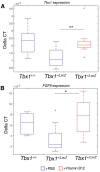Vitamin B12 ameliorates the phenotype of a mouse model of DiGeorge syndrome
- PMID: 28173146
- PMCID: PMC5409220
- DOI: 10.1093/hmg/ddw267
Vitamin B12 ameliorates the phenotype of a mouse model of DiGeorge syndrome
Erratum in
-
Vitamin B12 ameliorates the phenotype of a mouse model of DiGeorge syndrome.Hum Mol Genet. 2017 Nov 15;26(22):4540. doi: 10.1093/hmg/ddx353. Hum Mol Genet. 2017. PMID: 29036321 Free PMC article. No abstract available.
Abstract
Pathological conditions caused by reduced dosage of a gene, such as gene haploinsufficiency, can potentially be reverted by enhancing the expression of the functional allele. In practice, low specificity of therapeutic agents, or their toxicity reduces their clinical applicability. Here, we have used a high throughput screening (HTS) approach to identify molecules capable of increasing the expression of the gene Tbx1, which is involved in one of the most common gene haploinsufficiency syndromes, the 22q11.2 deletion syndrome. Surprisingly, we found that one of the two compounds identified by the HTS is the vitamin B12. Validation in a mouse model demonstrated that vitamin B12 treatment enhances Tbx1 gene expression and partially rescues the haploinsufficiency phenotype. These results lay the basis for preclinical and clinical studies to establish the effectiveness of this drug in the human syndrome.
Figures




References
-
- Yagi H., Furutani Y., Hamada H., Sasaki T., Asakawa S., Minoshima S., Ichida F., Joo K., Kimura M., Imamura S., et al. (2003) Role of TBX1 in human del22q11.2 syndrome. Lancet, 362, 1366–1373. - PubMed
-
- Paylor R., Glaser B., Mupo A., Ataliotis P., Spencer C., Sobotka A., Sparks C., Choi C.H., Oghalai J., Curran S., et al. (2006) Tbx1 haploinsufficiency is linked to behavioral disorders in mice and humans: implications for 22q11 deletion syndrome. Proc. Natl. Acad. Sci. U. S. A, 103, 7729–7734. - PMC - PubMed
Publication types
MeSH terms
Substances
LinkOut - more resources
Full Text Sources
Other Literature Sources
Molecular Biology Databases

